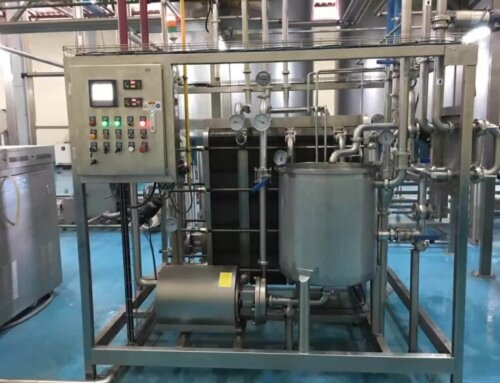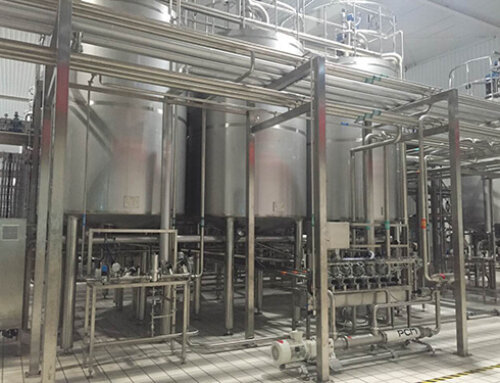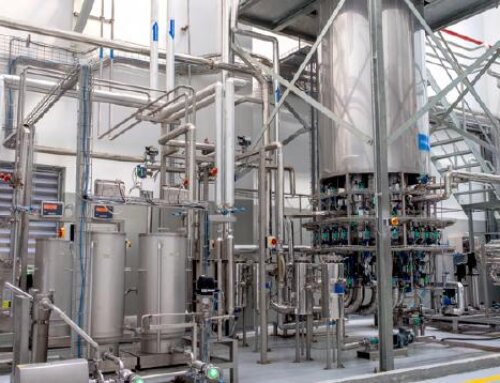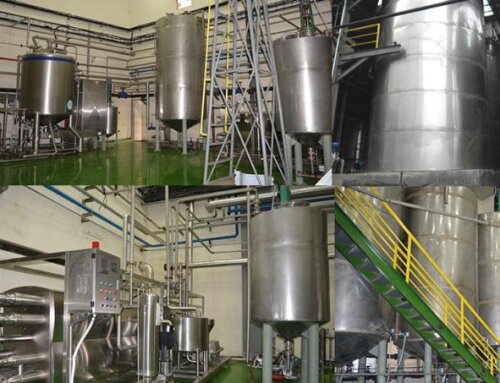Fruit Concentrate Plant Description
Concentrated fruit juice or fruit pulp is made by squeezing the fruit into natural juice and then using the low-temperature vacuum concentration method to evaporate some of the water. When preparing 100% juice, an equivalent amount of water lost during the concentration process must be added back to the concentrated juice to restore the natural water content, the final product should have the color, flavor, and soluble solids content similar to that of the original fruit pulp.
After fruit juice is concentrated, its volume and weight are greatly reduced, and its transportation and storage are more efficient, which is especially suitable for exporting to countries with a shortage of fruit resources. Concentrated juice is widely used as a food raw material in the production of various juices, beverages, desserts, yogurt, ice cream and other food and beverage products.
The fruit concentrate production process involves fresh fruits washing and sorting, fruit pulp/juice extracting, juice or pulp concentrating, concentrated juice or puree sterilizing and filling system.
The fruit concentrate plant machines all uses SUS304 material and adopt low-temperature concentrations, which can guarantee the end products are sanitary and high quality.
The capacity of the fruit concentrate processing plant is from 1 ton per hour to 30 tons per hour, and the end products can be filled into aseptic bags in drums or bulk soft bags.
The concentrated fruit juice or fruit pulp concentrate method mainly uses a low-temperature vacuum evaporator to do the concentration, now the membrane concentration is also being used for concentration because of low-temperature concentration as a new concentrate technology.
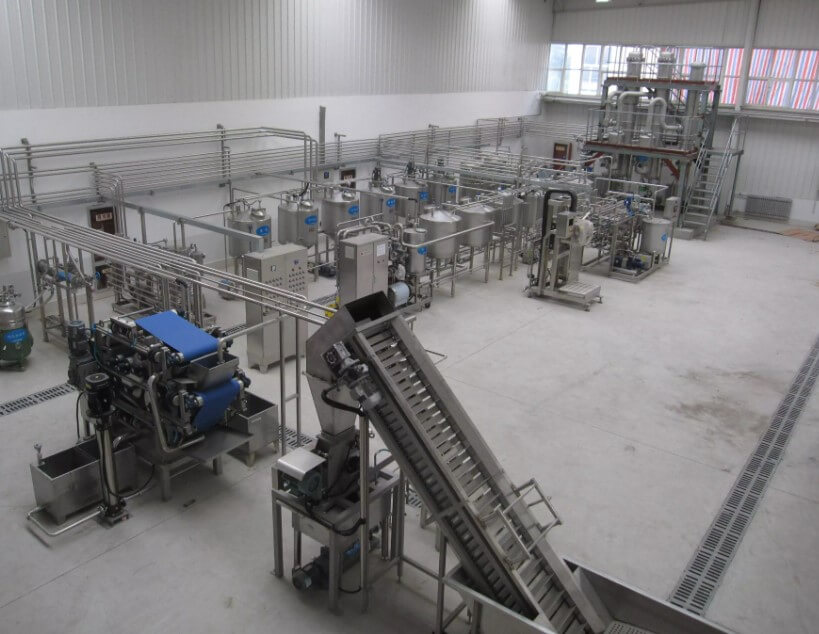
Fruit Concentrate Plant End Products and Package
Concentrated fruit Juice: The fruits with less pulp and tissue are suitable for the production into concentrated juice such as apple, orange, pomegranates, grapes, and pineapple fruits. The juice will be usually concentrated into 50-70 Brix according to different fruits, and the end products can be packed into bulk bags in drums or IBC containers.
Concentrated fruit Puree: Fruits rich in pulp are suitable for making concentrated fruit purees such as mango, guava, papaya, berry, tomatoes and other fruits. The fruit puree will be concentrated into about 30-40 Brix, after sterilization, the pulp concentrate will be filled into aseptic big bags.

Fruit Concentrate Plant Production Process Introduction
Fresh fruit pretreatment system
The fresh fruit pretreatment system includes the following process:
- Fruit Reception and Inspection: Fresh fruits are received and unloaded into the processing area and inspected for quality, and any damaged or rotten fruit is removed.
- Fruit Washing and Cleaning: Fruits are thoroughly washed using bubble water jets or brush washer to remove dirt, pesticides, and other contaminants. The disinfectant solution and pure water are used to wash these fruits.
- Fruit Sorting and Grading: Fruits are sorted and graded based on size, color, or ripeness, using mechanical or optical sorting systems.
- Peeling and De-Stoning (if required): Peeling Machines: Fruits like apples, oranges, and peaches are peeled using mechanical peelers, steam peelers, or chemical peelers; De-Stoning/De-Pitting: For fruits with pits or stones, such as cherries or peaches, specialized machines remove these hard parts.
- Cutting and Crushing: Cutting Machines: Fruits are cut into smaller pieces or slices, depending on the final product requirements; Crushing: In some cases, fruits are crushed to break down the cell structure, making it easier to extract juice or puree.
- Blanching (Optional): Some fruits may undergo blanching (briefly heating in hot water or steam) to inactivate enzymes that cause spoilage or to soften the fruit for further processing.
- Enzyme Treatment (Optional): Certain enzymes might be added to break down pectin or other components in the fruit, improving juice yield or clarity.

Fruit Juice or fruit pulp extraction system
Fresh fruits are milled and break down the cell walls to release the juice or pulp. For different fruits, the juice or pulp extraction methods are also different, the following are the common machines used for fruit juice or pulp extraction:
- Hydraulic Cold Presses: Used for pressing juice out of fruits with higher pulp content, like berries or citrus fruits.
- Screw Presses: Used for continuous extraction from fruits like apples, where the crushed fruit is pressed to separate the juice.
- Belt Presses: Commonly used for large-scale juice extraction, where crushed fruit is squeezed between belts.
- Centrifugal Juicers: Separate juice by spinning the fruit at high speeds, forcing juice out through centrifugal force.
- Pulper-Finishers: These are used for softer fruits (like mangoes or tomatoes) to separate the pulp from seeds, skins, and other fibrous materials. They often include screens that allow the pulp or juice to pass through while retaining larger solid particles.
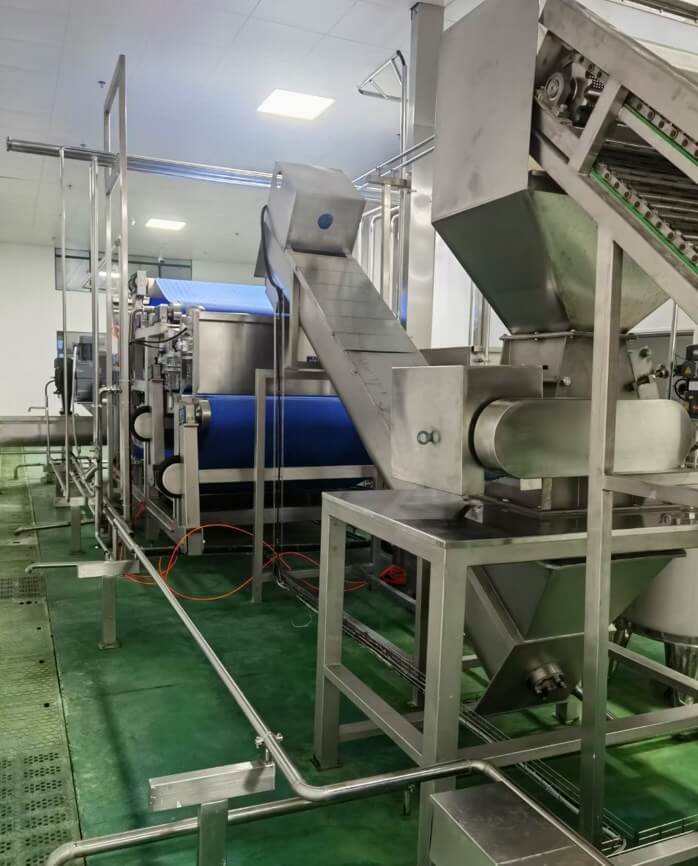
Fruit juice or fruit pulp separating or filtration system
- Centrifuge Separator Unit: To produce clear juice or remove the big solids in fruit pulp, the liquid might go through a clarification process where suspended solids are removed using clarifying agents or centrifuge separators.
- Filtration Units: These may include plate filters, rotary vacuum filters, or ultrafiltration systems to achieve the desired clarity.

Fruit juice or fruit pulp concentrate system
The core of the fruit concentrate plant is the evaporation system, typically conducted under reduced pressure (vacuum conditions) to lower the boiling point of the juice or pulp. This allows water to be removed at lower temperatures, preserving heat-sensitive flavors, nutrients, and color. It is typically divided into two types of evaporators:
- Fruit pulp forced circulation evaporator: The forced circulation evaporator is suitable for evaporating high solids fruit puree products, using low temperature(40-80℃) to evaporate the pulp into 30-40 Brix.
- Fruit juice falling Film Evaporators: These are commonly used for fruit juice concentration, where the juice flows down the inner walls of tubes in a thin film, and water is evaporated under a vacuum.

Concentrated fruit juice or fruit pulp sterilizing and filling system
Fruit pulp concentrate sterilization uses a tube-in-tube sterilizer or scraped surface heat exchanger to do the heat treatment, the sterilizing temperature and time are about 105-115℃ for 30-120S based on different fruit puree, after sterilizing, the concentrated pulp will be filled into aseptic bags.
Fruit juice concentrate are using tubular sterilizer to do UHT heat treatment or pasteurization according to different package and storage conditions. If the juice is filled into aseptic bags and needs to be stored in room temperature, then it will need to use UHT sterilizer to do the heat treatment(95-110℃holding for 15-30S); If the juice concentrate is filled into soft bags and stored in the frozen warehouse, then the tubular pasteurizer (85-95℃ for 10-30S) will be OK.



